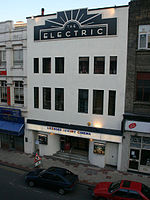Gateway Plus

The Gateway Plus (previously known as Birmingham Gatewayand now known as Grand Central) project was a redevelopment scheme that regenerated Birmingham New Street railway station and the Pallasades Shopping Centre above it in Birmingham, England. It was completed in September 2015. The project aimed to enhance the station to cope with increased passenger numbers as well as expected future growth in traffic, but did not alter the train capacity of the station. In 2008, the station handled passenger numbers far in excess of the capacity of its existing design. The current station and Pallasades Shopping Centre were completed in 1967 and became the subject of criticism for the congestion of the station and shabbiness of the shopping centre and parts of the station. It is part of the Big City Plan.
Excerpt from the Wikipedia article Gateway Plus (License: CC BY-SA 3.0, Authors, Images).Gateway Plus
Birmingham
Geographical coordinates (GPS) Address Nearby Places Show on map
Geographical coordinates (GPS)
| Latitude | Longitude |
|---|---|
| N 52.477772222222 ° | E -1.89885 ° |
Address
Pret A Manger
B2 4PX Birmingham
England, United Kingdom
Open on Google Maps








